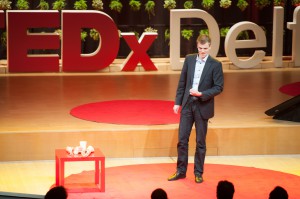TEDxDelft 2013 | Gerwin Smit- breaking the vicious circle of user dissatisfaction
 The prostheses we have today have not changed for more than 100 years: they don’t look like hands; they are hard to operate; or, they don’t provide an accurate enough grip. They are not very reliable, either. There is another huge problem: they are very heavy. You can literally say that the problem outweighs the benefits.
The prostheses we have today have not changed for more than 100 years: they don’t look like hands; they are hard to operate; or, they don’t provide an accurate enough grip. They are not very reliable, either. There is another huge problem: they are very heavy. You can literally say that the problem outweighs the benefits.
The current answer to this is to add more functions, making the prosthesis more complex, and heavier- and the users even more dissatisfied with their artificial hands- a vicious circle!
Enter Gerwin Smit, a PhD fellow at the TU Delft. His idea is to make the device much lighter by focusing on body-powered devices rather than electric ones. Thinking about ways to reduce friction in a body-powered artificial hand, Gerwin then looked at airplanes and cars (yes, airplanes and cars) that use hydraulic cylinders for their brakes.
Not being able to find cylinders that were sufficiently small, Gerwin made his own, tiny cylinder that was so small that it could fit into a human finger. By combining hydraulic cylinders of different sizes, Gerwin was able to make a very light, very accurate, body-powered prosthetic hand- which, at only 152 grams- is actually the lightest prosthetic hand ever!
The hand was tested at the University- and it passed all tests, but the story of the light prosthesis doesn’t end here. Gerwin’s dream is to bring the prosthesis outside of the university. He wants the patients to try it over at their houses, during everyday activities, “like working, studying, or tying their shoelaces”.
Helping patients who have lost an upper limb seems like an important matter to me- Gerwin’s idea is definitely worth spreading!
